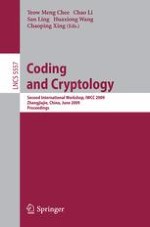This book constitutes the refereed proceedings of the Second International Workshop on Coding and Cryptology, IWCC 2009, held in Zhangjiajie, China, in June 2009. The 21 revised full technical papers, except one, are contributed by the invited speakers of the workshop. The papers were carefully selected during two rounds of reviewing and improvement for inclusion in the volume and address all aspects of coding theory, cryptology and related areas - such as combinatorics - theoretical or applied. Topics addressed are coding theory, secure codes, hash functions, combinatorics, boolean functions, authentication, cryptography, protocols, sequences, and secure communications.

